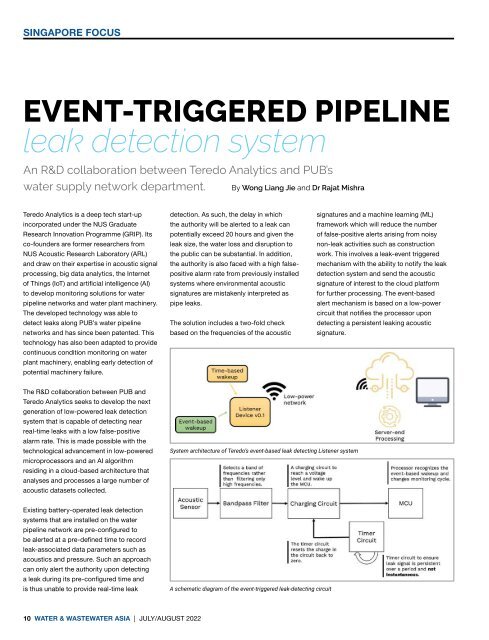Water & Wastewater Asia July/August 2022
Water & Wastewater Asia is an expert source of industry information, cementing its position as an indispensable tool for trade professionals in the water and wastewater industry. As the most reliable publication in the region, industry experts turn this premium journal for credible journalism and exclusive insight provided by fellow industry professionals. Water & Wastewater Asia incorporates the official newsletter of the Singapore Water Association (SWA)
Water & Wastewater Asia is an expert source of industry information, cementing its position as an indispensable tool for trade professionals in the water and wastewater industry. As the most reliable publication in the region, industry experts turn this premium journal for credible journalism and exclusive insight provided by fellow industry professionals. Water & Wastewater Asia incorporates the official newsletter of the Singapore Water Association (SWA)
You also want an ePaper? Increase the reach of your titles
YUMPU automatically turns print PDFs into web optimized ePapers that Google loves.
SINGAPORE FOCUS<br />
EVENT-TRIGGERED PIPELINE<br />
leak detection system<br />
An R&D collaboration between Teredo Analytics and PUB’s<br />
water supply network department. By Wong Liang Jie and Dr Rajat Mishra<br />
Teredo Analytics is a deep tech start-up<br />
incorporated under the NUS Graduate<br />
Research Innovation Programme (GRIP). Its<br />
co-founders are former researchers from<br />
NUS Acoustic Research Laboratory (ARL)<br />
and draw on their expertise in acoustic signal<br />
processing, big data analytics, the Internet<br />
of Things (IoT) and artificial intelligence (AI)<br />
to develop monitoring solutions for water<br />
pipeline networks and water plant machinery.<br />
The developed technology was able to<br />
detect leaks along PUB’s water pipeline<br />
networks and has since been patented. This<br />
technology has also been adapted to provide<br />
continuous condition monitoring on water<br />
plant machinery, enabling early detection of<br />
potential machinery failure.<br />
detection. As such, the delay in which<br />
the authority will be alerted to a leak can<br />
potentially exceed 20 hours and given the<br />
leak size, the water loss and disruption to<br />
the public can be substantial. In addition,<br />
the authority is also faced with a high falsepositive<br />
alarm rate from previously installed<br />
systems where environmental acoustic<br />
signatures are mistakenly interpreted as<br />
pipe leaks.<br />
The solution includes a two-fold check<br />
based on the frequencies of the acoustic<br />
signatures and a machine learning (ML)<br />
framework which will reduce the number<br />
of false-positive alerts arising from noisy<br />
non-leak activities such as construction<br />
work. This involves a leak-event triggered<br />
mechanism with the ability to notify the leak<br />
detection system and send the acoustic<br />
signature of interest to the cloud platform<br />
for further processing. The event-based<br />
alert mechanism is based on a low-power<br />
circuit that notifies the processor upon<br />
detecting a persistent leaking acoustic<br />
signature.<br />
The R&D collaboration between PUB and<br />
Teredo Analytics seeks to develop the next<br />
generation of low-powered leak detection<br />
system that is capable of detecting near<br />
real-time leaks with a low false-positive<br />
alarm rate. This is made possible with the<br />
technological advancement in low-powered<br />
microprocessors and an AI algorithm<br />
residing in a cloud-based architecture that<br />
analyses and processes a large number of<br />
acoustic datasets collected.<br />
System architecture of Teredo’s event-based leak detecting Listener system<br />
Existing battery-operated leak detection<br />
systems that are installed on the water<br />
pipeline network are pre-configured to<br />
be alerted at a pre-defined time to record<br />
leak-associated data parameters such as<br />
acoustics and pressure. Such an approach<br />
can only alert the authority upon detecting<br />
a leak during its pre-configured time and<br />
is thus unable to provide real-time leak<br />
A schematic diagram of the event-triggered leak-detecting circuit<br />
10 WATER & WASTEWATER ASIA | JULY/AUGUST <strong>2022</strong>


















